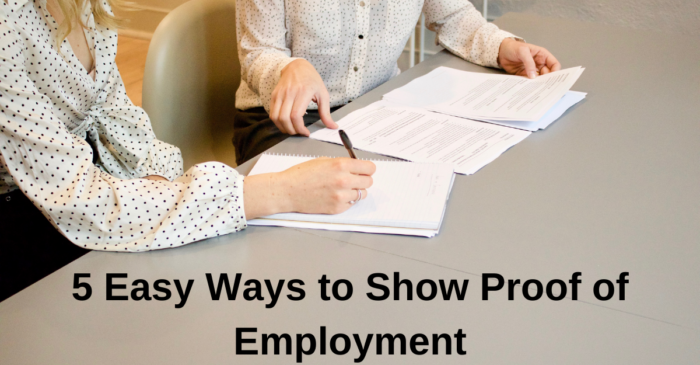
When it comes to providing proof of employment, there are several straightforward methods that can easily validate your work status. These documents serve as concrete evidence of your association with an employer, ensuring that you can meet various requirements. Whether you’re applying for a loan, renting an apartment, or undergoing a background check, having show proof of employment is crucial.
- Employment Verification Letter: One of the simplest ways to obtain proof of employment is through an employment verification letter. This official document, provided by your employer, confirms your current or past employment status, job title, salary, and other relevant details. It is commonly accepted by banks, landlords, and government agencies as authentic proof of employment.
- Pay Stubs: Pay stubs are another effective way to demonstrate proof of employment. These regular documents issued by your employer outline your salary, deductions, and any additional income. Pay stubs typically include the employer’s name, your name, and the pay period, offering verifiable evidence of your employment status and income.
- Employment Contract: An employment contract is a binding agreement between you and your employer that outlines the terms and conditions of your employment. This document clearly states your job role, responsibilities, compensation, benefits, and the duration of your employment. Providing a copy of your signed employment contract can serve as compelling proof of employment.
- Bank Statements: Although not as direct as other methods, bank statements can still be used to show proof of employment. Regular deposits from your employer into your bank account demonstrate a consistent income stream, implying stable employment. It’s advisable to accompany bank statements with other official documents for stronger evidence.
- Tax Returns: Presenting your tax returns can be a solid way to verify your employment status and income over a specific period. Tax documents, such as W-2 forms, provide comprehensive details of your earnings, taxes paid, and employer information. Tax returns are considered reliable proof of employment for various purposes.
1. Show Your “Employment Verification Letter”
If you need a more formal and official way to provide proof of employment, obtaining an employment verification letter is the ideal solution. This document is issued directly by your employer and serves as a clear and concise statement of your current or past work status. The employment verification letter includes essential information, such as your name, job title, start date, and, if applicable, end date. It may contain details about your salary, working hours, and any other relevant employment-related information.
When requesting an employment verification letter, ensure that it is printed on the company’s official letterhead and signed by an authorized representative. This ensures its authenticity and credibility, making it widely accepted and recognized by various institutions, such as banks, government agencies, and landlords.
Employment verification letters are particularly valuable in situations where a more comprehensive overview of your employment history is required. They provide a comprehensive summary of your work experience, making them a valuable asset when applying for new jobs or securing professional certifications.
2. Pay Stubs: The Evident Confirmation of Employment
When it comes to providing the most obvious and direct proof of employment, pay stubs undoubtedly take the lead. These regular documents issued by your employer serve as a tangible and verifiable demonstration of your work status and income. A pay stub contains essential details such as your name, the employer’s name, pay period, gross earnings, deductions, and net pay. This comprehensive information leaves no room for doubt and is widely accepted by various institutions and authorities as concrete proof of employment.
Pay stubs offer a transparent breakdown of your earnings, allowing others to assess your financial stability and capacity to meet obligations. Whether you’re applying for a loan, leasing an apartment, or applying for government benefits, pay stubs provide compelling evidence of your employment, enabling the concerned parties to make well-informed decisions.
3. Show Your Tax Returns and Bank Statements
In addition to pay stubs and employment verification letters, providing your tax returns and bank statements can offer strong supplemental proof of employment. Tax returns are official documents submitted to the government, detailing your income, deductions, and taxes paid during a specific period. They serve as a reliable indicator of your employment status and financial stability over time, making them valuable evidence for various applications.
When presenting your tax returns as proof of employment, make sure to include all relevant forms, such as W-2s or 1099s, as they provide crucial information about your income sources and employer details. These documents substantiate your work history, making it easier for lenders, landlords, or other parties to assess your eligibility and trustworthiness.
4. Show Financial Statements From Your Business
If you are a business owner or self-employed, creating financial statements can serve as compelling proof of employment. These statements offer a comprehensive overview of your business’s financial performance and can demonstrate your stable income source and employment status. They are particularly useful when applying for loans, seeking partnerships, or showing your financial capability to potential clients.
Financial statements include an income statement, balance sheet, and cash flow statement. The income statement displays your business’s revenues and expenses, revealing your net profit or loss over a specific period. This statement reflects the success and viability of your business, underscoring your entrepreneurial efforts and, in turn, acting as proof of your employment through self-employment.
5. Show Your 1099s Form
If you work as an independent contractor or freelancer, your 1099 forms can serve as valuable proof of employment. A 1099 form is a tax document provided by clients or companies that have paid you at least $600 for services rendered during the tax year. It reports the total amount paid to you and is used to report miscellaneous income on your tax return.
When providing proof of employment as an independent contractor, presenting your 1099s can be crucial. These forms not only demonstrate that you have received income from multiple sources but also indicate that you are self-employed and responsible for reporting and paying taxes on your earnings.
To ensure the authenticity of your proof of employment, it is essential to keep accurate records of all your 1099s. You can obtain these forms from your clients or companies with whom you have worked as an independent contractor. Keep a organized record of all your 1099s, and consider retaining copies of invoices, contracts, or other agreements related to your freelance work to further substantiate your employment status.
The Importance of Having Proof of Employment

Having proof of employment is of utmost importance in various aspects of life. This documentation serves as a vital validation of an individual’s work status and income, enabling them to meet essential requirements and access numerous opportunities.
One significant importance of having proof of employment is in financial transactions. When applying for loans or credit, financial institutions and lenders need assurance that the borrower has a stable income source to repay the borrowed funds. Proof of employment, such as pay stubs, employment verification letters, or 1099 forms for freelancers, provides the necessary evidence to support the borrower’s loan application and increases their credibility as a reliable borrower.
Proof of employment is crucial when renting a property. Landlords require evidence of a tenant’s ability to pay rent regularly and on time. By presenting proof of employment, such as income statements or tax returns, prospective tenants can demonstrate their financial stability and increase their chances of securing the desired rental property.
FAQs
What is employment verification?
Employment verification is a process by which an individual’s work status and employment-related information are confirmed by an employer or a designated third-party agency. The purpose of employment verification is to provide credible proof of employment to validate an individual’s claims regarding their job history, income, and other relevant details. This verification process is often required by various entities, such as financial institutions, landlords, government agencies, and potential employers, to ensure accuracy and authenticity of the provided information.
To conduct employment verification, an employer issues an employment verification letter on official company letterhead. This letter contains essential details about the individual’s employment, including their job title, dates of employment, salary or wages, and any other relevant information, such as employment status (full-time, part-time, or contract basis). The employment verification letter serves as a formal and reliable source of proof of employment and is commonly accepted in various situations, such as loan applications, rental agreements, and immigration processes.
How do you respond to employment verification?
When responding to an employment verification request, it is essential to provide accurate and verifiable proof of employment. This process involves confirming the individual’s work status and relevant details to the requesting party, such as a lender, landlord, or government agency. The goal is to present a credible and formal response that validates the individual’s employment history and income.
The most common method of responding to an employment verification request is through an employment verification letter. This official document, issued by the employer on company letterhead, contains essential information about the individual’s employment, including their job title, dates of employment, salary or wages, and any other pertinent details. The employment verification letter serves as a reliable source of proof of employment and is widely accepted by various institutions as valid documentation.







You must be logged in to post a comment.